
As a family, it can be difficult to effectively and lovingly navigate through the rough waters of relationships. With many individual relationships happening within a family unit, finding harmony and balance isn’t always a walk in the park. Whether between parent and child, child and step-sibling, or step-parent and child, mindfulness exercises for families can be of great benefit. Helping us to see clearly what is really going on when tensions run high – and when things seem rather mundane.
Cultivating mindfulness in families begins with deepening our understanding of the factors that may make harmony seemingly hard to maintain. Some of the factors that make familial relationships difficult are simply due to our being human. While, others are due to the modern day environment.
Mindful Relationships
As we cultivate mindfulness within the family unit through the use of mindfulness exercises, our relationships improve through a variety of mechanisms. By enhancing our ability to be non-judgmentally present with what is within us and within those we care for. Mindfulness brings understanding, compassion, and acceptance of family members to the surface. Mindfulness:
1. Facilitates our ability to communicate – to both listen and express our feelings and needs from a place of love rather than fear.
2. Reduces habitual reactions, encouraging us to speak and act with greater presence and consciousness.
3. Enhances our self-awareness, encouraging us to take responsibility for our own actions and behavior.
4. Helps to both honor and regulate our emotions, making communication more effective.
5. Enhances compassion and empathy, strengthening our understanding of those we love and reduces our propensity to judge.
6. Reduces our perception of difference and heightens our understanding of connection.
Mindfulness does not mean that we will avoid confrontation or misunderstandings with family members. As humans, we are bound to see things differently from time to time. Mindfulness simply enhances our ability to find common ground amidst the perceived differences.
Mindfulness Activities for Families
There are a variety of ways we can incorporate mindfulness within the family unit. The age of our children will impact the way we explore these powerful practices. Keeping this in mind, here are some simple activities you can consider: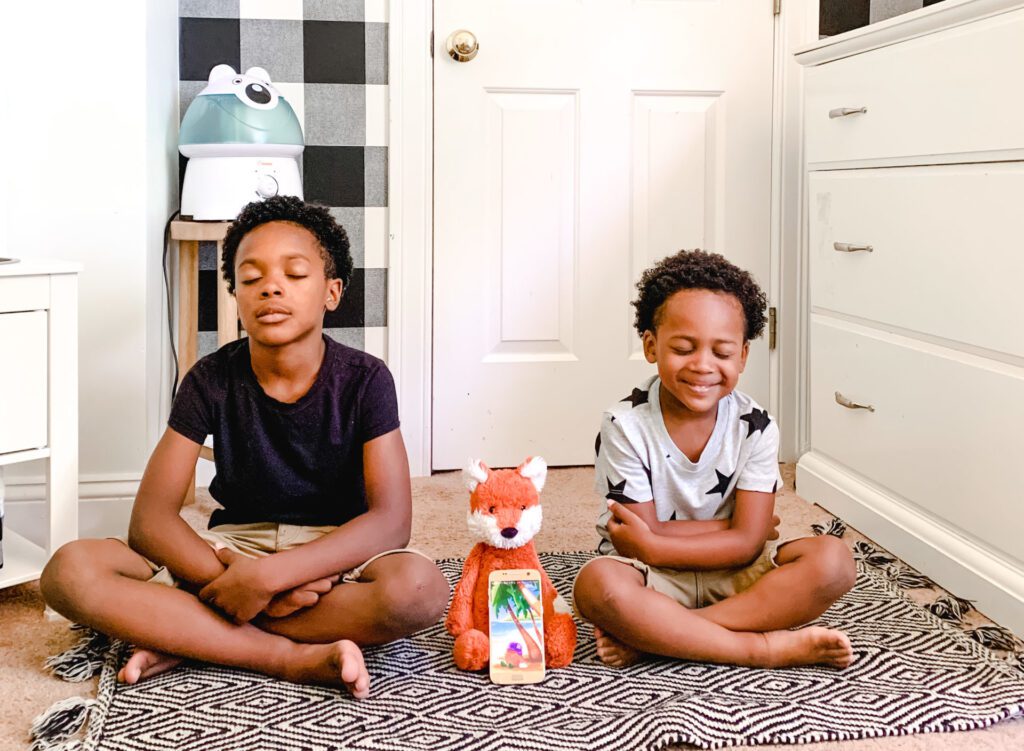
1. Gratitude-Giving Before Dinner: Going around the table before dinner to express gratitude is a powerful practice that enhances mindfulness of the abundance we have to be grateful for. Each family member can share one thing they are thankful for with a simple word or sentence – or with a more in-depth explanation as required. This practice can also spark meaningful conversation around the dinner table. Mindfulness Activities for Kids and Families
2. Sense Exploration: Particularly applicable with young children, sense exploration encourages kids to become more aware of their surroundings. This type of practice can be used to explore food. For instance, encouraging children to tune into all five senses as they take a bite of a piece of fruit or a cracker. It can also be explored. While out in nature, inviting children to tune into their sense of smell, touch, sound, sight, and taste (each where appropriate).
3. Emotion Exploration: Exploring emotions is a powerful practice that is useful for both children and adults (and those in-between). When emotions are strong, we can invite our children (and ourselves) to explore where these feelings are present in the physical body. And what they might be saying about who we are at present. Becoming inquisitive when emotions arise is a practice that will foster healthily relationships for children. Especially, as they grow up and as their relationships become more intimate and complex.
MINDFULNESS MULTIPLIER EFFECT™
 Mindfulness is a gift that you can offer yourself. By first giving the gift of Mindfulness to yourself you can then watch it spread to others. From Mindfulness with yourself, you inherently bring Mindfulness to everything you do and everyone you meet. This is the Mindful multiplier effect ™.
Mindfulness is a gift that you can offer yourself. By first giving the gift of Mindfulness to yourself you can then watch it spread to others. From Mindfulness with yourself, you inherently bring Mindfulness to everything you do and everyone you meet. This is the Mindful multiplier effect ™.
This ripple effect has no logical end because we’re dealing with intangible emotional & spiritual energy. The closest to the ripple being your family & loved ones. When you are mindful and positive, everything arounds you blooms and feels the energy.
SEVEN DAYS SEVEN WAYS OF Cultivating Mindfulness with Family
Day 1: Sun Breathe Mindfulness
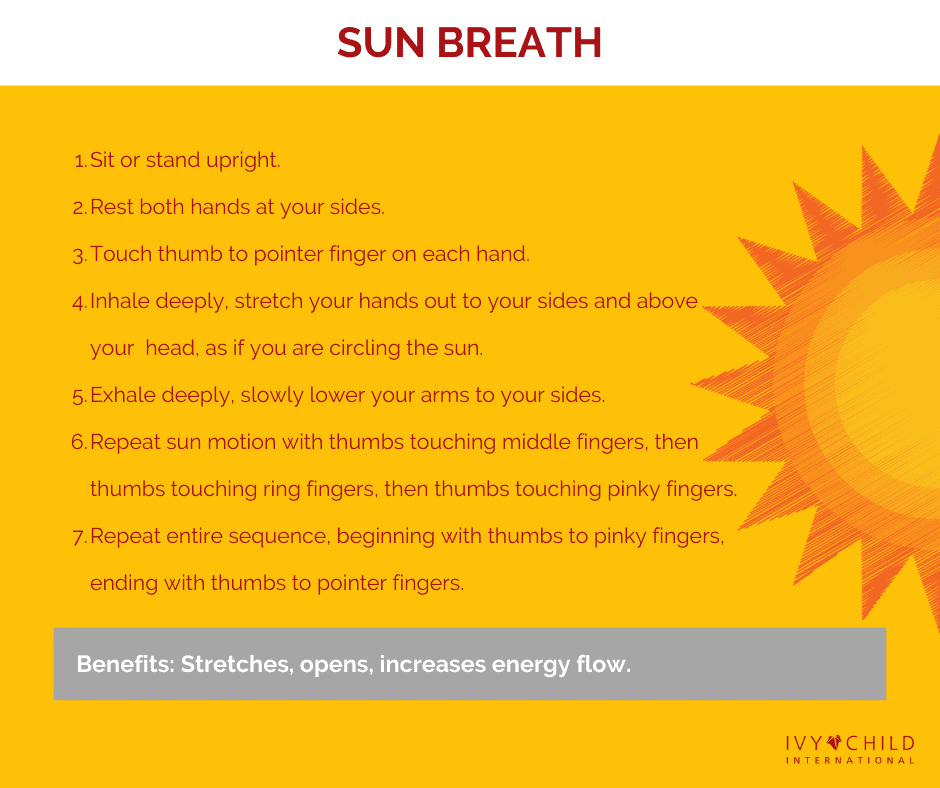 Sun Breath mindfulness is a dynamic sequence that focuses on the flow of arms with the breath. The breathing pattern (inhalation-hold-exhalation-hold) guides the movement of the arms that acts as a tool to bring more awareness to the body and breath. People who are new to yoga can be introduced to this kind of breathing, which helps them make faster connections to the sensations, feelings, and emotions felt during this dynamic Sun Breaths practice.
Sun Breath mindfulness is a dynamic sequence that focuses on the flow of arms with the breath. The breathing pattern (inhalation-hold-exhalation-hold) guides the movement of the arms that acts as a tool to bring more awareness to the body and breath. People who are new to yoga can be introduced to this kind of breathing, which helps them make faster connections to the sensations, feelings, and emotions felt during this dynamic Sun Breaths practice.
The seated position adds to the grounding practice, whereas the act of engaging the arms adds to the energy in the body-mind connection. In this practice the conscious breathing builds energy and with the simple movement of the arms it opens the heart which can release tension in the chest region to allow free flow of breath.
Sun Breaths flow can bring very subtle yet noticeable differences in the body. Some of the benefits of this practice are:
- Stretches and Strengthens: Sun Breaths can be done to gently stretch and strengthen the muscles of the chest, arms and shoulders. The dynamic movement of the arms when coordinated with the breath, helps to lengthen the spine when the arms are stretched upwards, lifting the torso from the base of the spine. This when done repeatedly can also strengthen and tone the shoulders and upper arms. The conscious efforts of broadening the shoulders and chest can also help with the confidence in oneself as it signifies being strong internally and externally.
- Chest and Breath: Sun Breaths is a gentle heart opener and opens the muscles in the chest region. This in turn expands the lungs and encourages the practitioner to take deeper and longer breaths. The quality of the breath can make a huge difference when it comes to healing or alleviating the symptoms of psychosomatic illnesses (physical illness due to a mental factor, such as hypertension, heart disease etc).
- Awareness and Focus: A dynamic flow like Sun Breaths, though simple, has the ability to hold the focus of the practitioner with the integration of breath and movement. Unlike the static poses where one can lose the awareness and focus during the counts, this pose keeps the body and mind alert throughout the practice. This can act as a wonderful foundation when practiced in the beginning of a yoga class by helping the students to forget the worldly worries and woes.
- Relaxing and Rejuvenating: A calm mind creates a calm body. Sun Breaths helps to calm the excess nervous energy in the mind by activating the Parasympathetic Nervous System (PNS). PNS is responsible for the “rest and digest” function of the body. It can help to gently boost energy in those who feel lethargic, dull or have depression. It can also help to reduce the anxious thoughts in the cases of anxiety, by encouraging to focus solely on the movement and breath combination. It must be noted that in chronic cases an expert medical diagnosis and treatment is necessary in order to heal.
Day 2: Setting Intentions
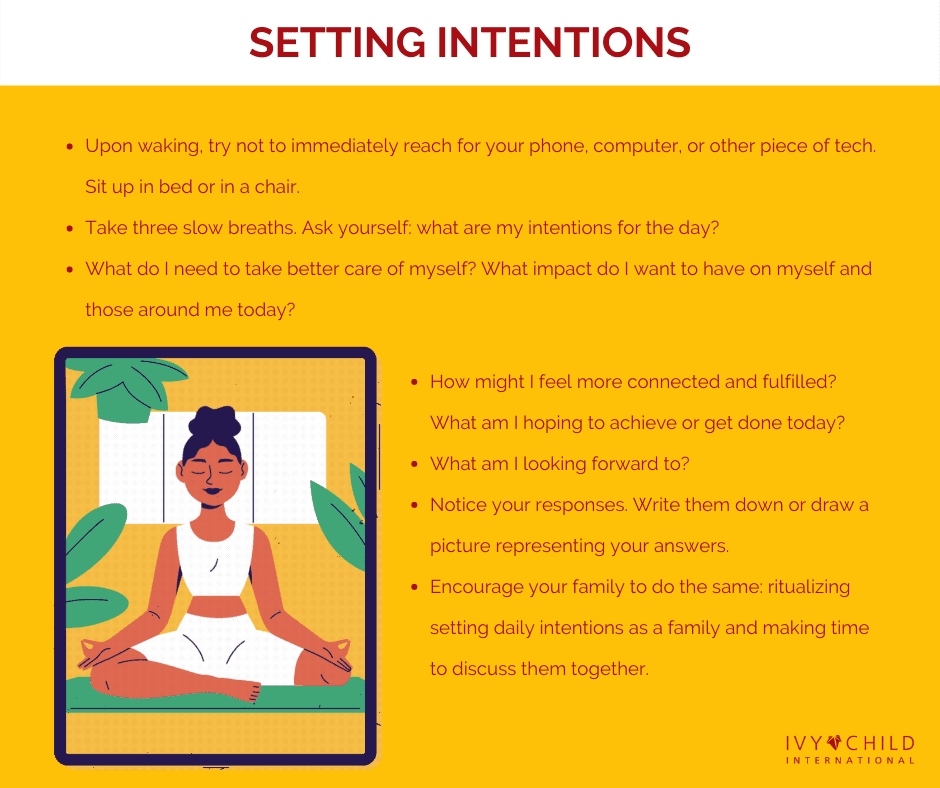 An intention is a guiding principle for how you want to be, live, and show up in the world — whether at work, in relationships, during your meditation, or in any area of your life. Ask yourself, what matters most to you? Your answer could form a powerful intention, for which you can align your thoughts and attitude for the day ahead. Having a clear intention with you at your fingertips can help guide your actions as you move through the day.
An intention is a guiding principle for how you want to be, live, and show up in the world — whether at work, in relationships, during your meditation, or in any area of your life. Ask yourself, what matters most to you? Your answer could form a powerful intention, for which you can align your thoughts and attitude for the day ahead. Having a clear intention with you at your fingertips can help guide your actions as you move through the day.
But an intention shouldn’t be confused with a goal — it’s not something you attach an expectation or evaluation to. It is something you want to align with in your life. It’s an aim, a purpose, or attitude you’d be proud to commit to.
Intentions must come from your heart; they are not the tangible “boost sales by 25%” or “get a promotion” kind of smart goals that you set at work. They are heart-driven and evoke feeling and purpose, like “practice being non-judgmental of myself and of others,” “send compassion out to the world,” “open my heart,” and “let go of fear”. Setting an intention is a way to bring your heart and mind into alignment.
Why Set Intentions?
Setting an intention at the start of a new year, on your birthday, when a new month begins, or at the beginning of your day or week can be a powerful practice because it’s the first step to embodying that which you want. Wayne Dyer said, “Our intention creates our reality.” And how many times have you heard “What you think, you become,” or “Thoughts become things”?
If you’re focusing your mind on a specific intention during a meditation, you are bringing it to your focused mind, your thoughts, your heart and in turn helping to bring it into your reality.
Here are some thought-starters to help you get started in forming an intention:
- What matters most to you?
- What would you like to build, create, or nurture in your life?
- What would you like to let go of?
- Who would you like to forgive in your life?
- How do you feel when you are your happiest self?
- What makes you proud?
- What word(s) would you like to align yourself with?
- What fears would you like to release?
- What are you grateful for?
- What are your wildest dreams?
Day 3 Happy Place Mindfulness
 Happy place meditation technique focus your mind to take you to a place where you can they feel happy, calm and at peace in times of high stress or anxiety, a stress management strategy that would give some control over your thoughts in a time where you feel nothing but out of control.
Happy place meditation technique focus your mind to take you to a place where you can they feel happy, calm and at peace in times of high stress or anxiety, a stress management strategy that would give some control over your thoughts in a time where you feel nothing but out of control.
Using the five senses; Sight, Sound, Touch, Smell & Taste you can envisage a time or place where you felt totally calm and at peace and can take yourself back to that place whenever you need to, in any environment, at school, home, in the car, during a test, at your work place or at a medical appointment.
How and When to Use Happy Place
Regular Daily Practice
– Set aside 5-10 minutes at a regular time in the morning or evening, or both to practice
– Practicing every day at regular times, will give you faster, easier access to your “safe place” at other times in the day.
Throughout the day
– Go to your “safe place” to calm you throughout the day: on the subway, waiting for an appointment, in the dentist chair, etc
– Find your own times and places to go to your “special place”
In stressful situations and/or emergencies
– When you find yourself starting to feel tense or anxious or in pain, close your eyes, and imagine yourself in your special place.
Day 4: Rework your surroundings
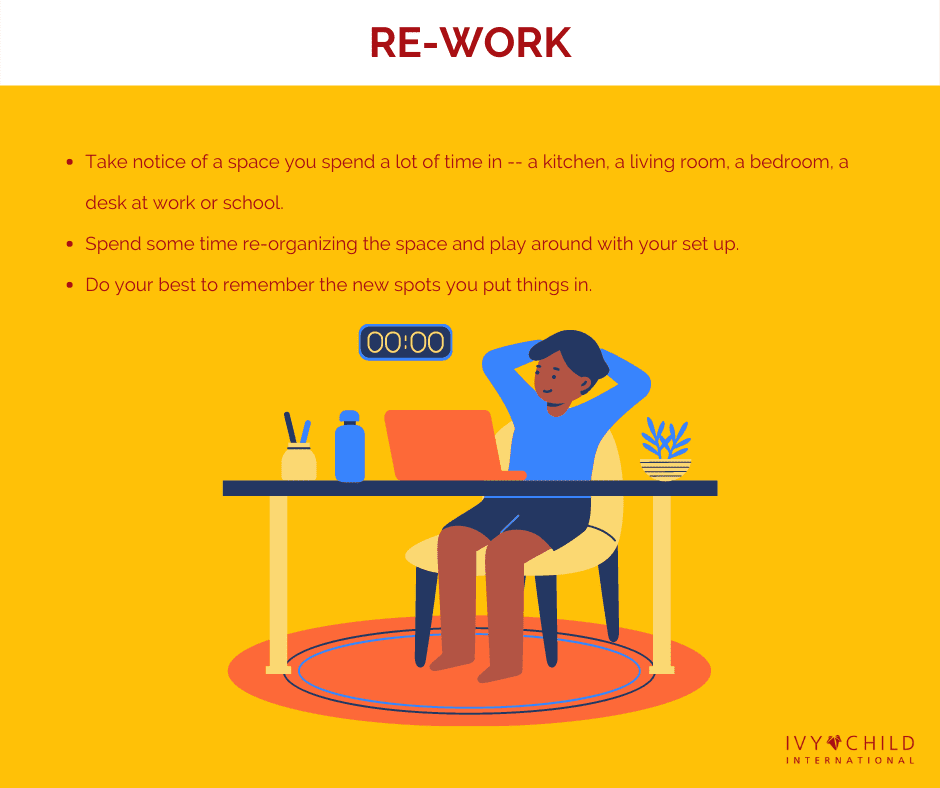 Being aware of what we are experiencing at a given moment, our sensations, thoughts and feelings, has been shown to enhance wellbeing.
Being aware of what we are experiencing at a given moment, our sensations, thoughts and feelings, has been shown to enhance wellbeing.
Although our thoughts are important for productivity and it’s natural to respond to stressors by thinking about them, learning to focus on the present moment can help lighten negative thinking patterns and maintaining a level of calmness. When we focus on the present moment, we can step back from our thoughts to see their patterns. We can train ourselves to recognize when our thoughts are taking over and learn to let go of patterns that are not helpful.
Being present and taking notice should be something we do daily. Observing our surroundings and reflecting on our thoughts without getting lost in them are small ways we can be mindful. Take a look at the simple suggestions and local opportunities for ideas on how to take notice and be mindful.
Simple Suggestions to rework your surroundings
- Try “Stop – Calm – Rest – Notice.” Stop, take 10 mindful breaths, and rest while you notice the sights, sounds, and smells around you and the feelings within you.
- Walk around your neighbourhood and look to discover something new.
- Take pictures with a camera or try drawing or painting what you see.
- Write in a journal.
- Pick a regular time each day to stop or walk and pay particular attention to your surroundings.
- When engaging in the other “ways” to wellbeing, stop to notice how you’re connecting, being active, learning, or giving and reflect on how these activities make you feel.
- Spend time outside and enjoy nature.
- Try keeping a gratitude diary where you take a few minutes each day to appreciate small moments, things or people in your life.
- Sit quietly in a busy place and notice the interactions around you.
Day 5: Let’s get Fruity
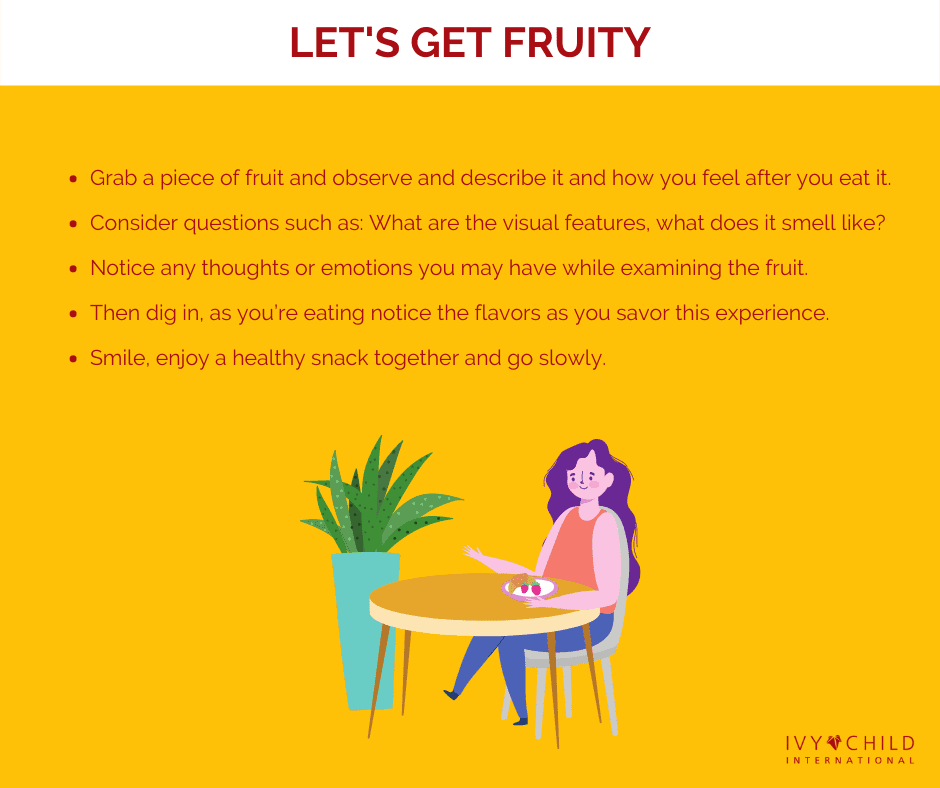 Fruity mindfulness is a way to practice mindfulness in order to overcome negative thoughts and feelings. The following simple exercise teaches us how eating fruit can help us to be more mindful and invites us to bring mindful awareness to activities we may already do in everyday life.
Fruity mindfulness is a way to practice mindfulness in order to overcome negative thoughts and feelings. The following simple exercise teaches us how eating fruit can help us to be more mindful and invites us to bring mindful awareness to activities we may already do in everyday life.
Take your time doing this mindfulness practice, noticing whatever you notice and experiencing whatever you experience. Don’t worry, it’s impossible to get this wrong!
We talk about practising mindfulness because our ability to be mindful is always developing. It is really important to remember that when we shine the torch of our awareness, we are not trying to change the detail of what the light picks up; just the direction of the beam and how broadly the torch beam spreads. We are choosing the focus of our attention and the detail of our experience that we are opening our awareness to.
Day 6: Shoot for your dreams
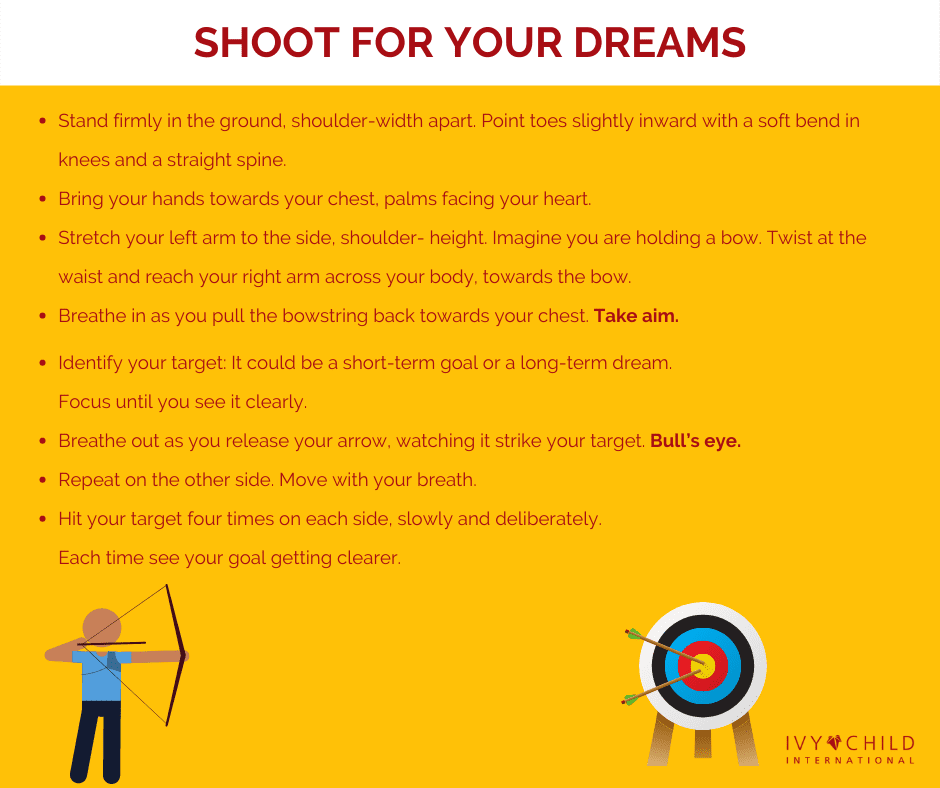 Mindfulness / Meditation is a proven method of relaxing both the mind and the body.
Mindfulness / Meditation is a proven method of relaxing both the mind and the body.
In order to meditate, all you need is:
- a safe space,
- proper breathing,
- a mental point of focus,
- and the ability to think of nothing else but the present moment.
Anyone can do it. Taking some time every day to quiet your mind, take a deep breath, and center yourself through a skill as old as humankind itself.
Mindfulness, brought into your daily life, can help many of life’s stresses and struggles that modern life can throw at us.
Troubles can come at use so fast that it can be very difficult to cope. It is sometimes so very easy to get swept away in a tornado of negativity. Without a daily practice to bring us back to a calm centre and clear my mind life can become very difficult. That can lead to low self esteem, depression , addiction and much more.
Mindfulness encourages you to aim for your dreams and shoot with all the positivity you have.
The process of mastering the bow is more than just getting good with a weapon. In order to achieve perfection, one must be able to focus, clear their mind, and concentrate on the simple movements involved. So when it comes to archery remember that if what you are doing is instinctive, devoid of analytical thought, and pure in intent, then you are practicing a form of meditation.
Breathing and concentration are paramount with the old stick and string. You have to keep control of your breath as it’s important not to let the arrow go when you exhale, as it could collapse your shoulders and throw off your aim.
When you shoot an arrow the whole world disappears. You think about your form, the arrow, and the target. Your vision narrows until your staring at a tiny dot on the target.
Inhale.
Exhale.
Inhale.
Day 7: Gratitude Mindfulness
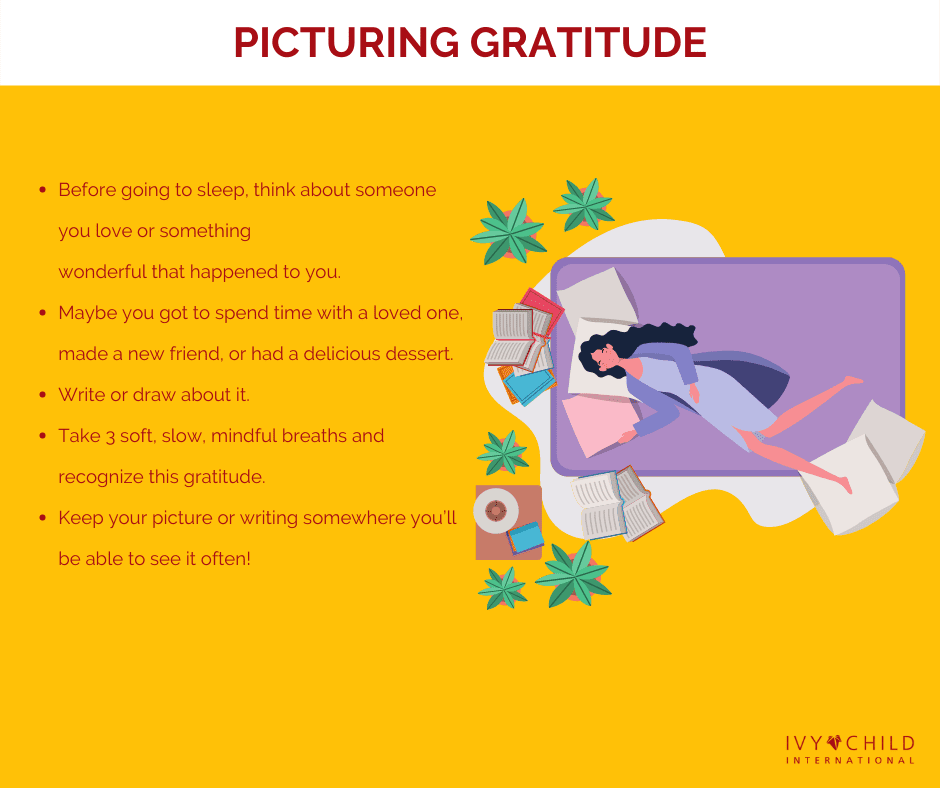 We say “thanks” a dozen or more times a day: when someone holds a door open, bags our groceries, puts a report on our desk. It’s a reflex, an almost knee-jerk reaction to simple daily transactions. We mutter it, often without really acknowledging the person we’re thanking.
We say “thanks” a dozen or more times a day: when someone holds a door open, bags our groceries, puts a report on our desk. It’s a reflex, an almost knee-jerk reaction to simple daily transactions. We mutter it, often without really acknowledging the person we’re thanking.
Yet as easy as it is to engage in the quotidian “thanks—no problem” exchange in our daily routines, we’re often left, in moments of larger generosity, feeling unworthy or embarrassed by what’s being offered. If you’ve ever thwarted a friend’s attempt to treat you to dinner or received a gift that you insisted was “too much,” you may be struck by that thankfulness gap.
Practicing kindness and gratitude is one of the most direct routes to happiness: Research suggests that kind people tend to be more satisfied with their relationships and with their lives in general. We all have a natural capacity for kindness, but sometimes we don’t take steps to nurture and express this capacity as much as we could.
Building your capacity for gratitude isn’t difficult. It just takes practice.
The more you can bring your attention to that which you feel grateful for, the more you’ll notice to feel grateful for! Simply expressing gratitude may have lasting effects on the brain, noting that practicing gratitude can lead to greater sensitivity to the experience of gratitude in the future.
- Start by observing. Notice the “thank you” you say. Just how habitual a response is it? Is it a hasty aside, an afterthought? How are you feeling when you express thanks in small transactions? Stressed, uptight, a little absent-minded? Do a quick scan of your body—are you already physically moving on to your next interaction?
- Pick one interaction a day. When your instinct to say “thanks” arises, stop for a moment and take note. Can you name what you feel grateful for, even beyond the gesture that’s been extended?

